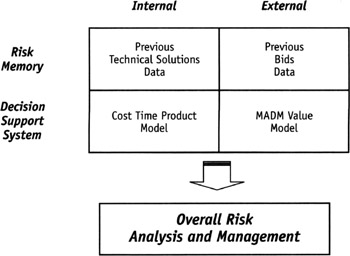PRIMA Decision Support System
|
A DSS is an interactive, flexible, and adaptable computer-based information system (CBIS) that utilizes decision rules and models coupled with a comprehensive database and the decision-maker's own insights, leading to specific decisions in solving problems that would not be amenable to management science optimization models, per se. Thus, a DSS supports complex decision-making and increases its effectiveness.
A DSS is composed of the following parts:
-
Data management. It includes the database(s), which contains relevant data and it is managed by software called database management systems (DBMS).
-
Model management. A software package that includes financial, statistical, management science, or other quantitative models that provide the system's analytical capabilities and an appropriate software management.
-
Communication. Interface with user.
The architecture of PRIMA DSS is described in Figure 5. The main modules composing the DSS are:

Figure 5: Architecture of PRIMA Decision Support System
-
Estimate module (allowing for cost, time, and performance point estimates based on drivers, coefficients, and factors)
-
Statistical module (allowing for a measure of the forecasting capability of the company based on data records and expert judgment)
-
Risk breakdown structure (allowing for an identification and classification of the major risk sources)
-
Work breakdown structure (allowing, through cross analysis with RBS and at a given level of detail, the identification of the major risk events, their probability, and consequence in terms of deviations from expected values of cost, time, and product performance)
-
Simulation models (value, cost, time, and product models which allow, through simulation, the assessment of the overall risk in terms of time, cost, and product performance using input data coming from the statistical module for each risk event)
-
Risk evaluation module (allowing for a tradeoff between external risk and internal risk, identifying possible actions to reduce overall risk level).
The increasing complexity of projects and products leads to the analysis of huge amounts of data. Moreover, the bidding process requires the involvement of different skills and resources in a very short period of time, based on knowledge sharing, both over space and time. A formal process of knowledge acquisition, structuring, accumulation, sharing, reuse, and adaptation to new cases makes a cooperative approach to work and a learning process at company level possible.
The PRIMA DSS focuses on trading off external risk analysis (i.e., analysis of uncertainty about bid competitive value following a top-down approach) and internal risk (i.e., analysis of uncertainty about possible deviations from project baseline following a bottom-up approach). The trade-off between these two sides of project risk is normally obtained by an iterative process allowing for a progressive adjustment of the bid profile, taking into account the several aspects involved.
In the case of the PRIMA RMCM the main information sources are data records and expert knowledge. The relative weight of these two types of sources may change: the more non-repetitive a project element is, the more important the expert judgment during the assessment phase is. On the contrary for repetitive elements, data records may exercise a greater influence in the assessment. The integration between available data records—generally limited by project "one-of-a-kind" features—and subjective judgments elicited by experts on the basis of previous experience about similar projects is an inherent issue of the knowledge engineering process.
The approach to cope with the quantitative aspect of the proposal preparation process is often deterministic, since only "point estimate" values are used for the input parameters of the models applied to estimate both the bid competitive value and the project baseline respectively (e.g., activities' budget and duration). But, as previously mentioned, the early phase of the project is characterised by a high level of uncertainty, affecting both competitive factors and cost/time/performance parameters. As a consequence, during the risk quantitative assessment phase—following the risk identification phase and anticipating the risk response development and risk response control phases—in order to safeguard contractor's uncertainty and nevertheless assess the risk implied in the project, an approach based on "distribution estimate"—and not on "point estimate"—should be applied when estimating parameters related to bid competitive value and project baseline. Distribution estimates can represent both the uncertainty of an individual involved in the decision process and the dispersion of judgments in a group decision-making process.
Such a distribution estimate allows for a greater information content to be used in the early phase of the project and for an answer to new questions—impossible to answer with the traditional deterministic approach—such as: How probable is the success of our bid? How confident are we about the possibility to comply with given constraints in terms of budget and duration? Is it worth carrying out research to reduce uncertainty through gathering further information?
Only the availability of a RMCM allows for an implementation of a distribution estimate approach and, as a consequence, an evaluation of the likelihood of a given budget or completion date estimates. Considering for instance data records, the shift from an "expected value" (point estimate) approach to a "distribution estimate" approach should imply an evaluation of the company forecasting capability. Distributions of forecasting errors—i.e., deviations of actual values about time/cost/performance from the expected values—stemming from data records and adjusted by experts opinion, may be used to obtain a distribution estimate for each relevant project element, considering both competitive factors and project baseline parameters. Since the main information sources are data records and expert knowledge, a distribution estimate should stem from a rigorous integration of both sources, based for instance on a Bayesian approach.
|
EAN: 2147483647
Pages: 207